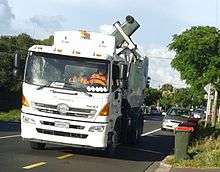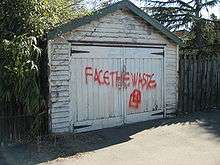Waste in New Zealand

The management of waste in New Zealand has become more regulated to reduce associated environmental issues.
History
Until recently, waste was taken to local rubbish dumps with little or no control as to where they were sited. Often the dumps were close to water ways. In recent years the location of dumps was consolidated and they are now constructed as sanitary landfills to prevent leaching of the contents into water bodies. Transfer stations, especially in cities, act as a local collection point where the waste is compacted before being transported to the nearest landfill.
In 2007 the OECD Environmental Performance Reviews for waste gave the following recommendations: [1]
- develop national regulations for managing hazardous waste
- expand and upgrade waste treatment and disposal facilities
- increase regulatory support for recovery or recycling
- clarify liability arrangements for remediation of contaminated sites
Volumes
Christchurch

Waste volumes from kerbside collections was almost 40,000 tonnes but reduced after the introduction of kerbside recycling and a halving in the number of free rubbish bags. In 2009 the Council introduced 140 litre wheelie bins for kerbside collection after which waste volumes began to rise.[2]
Types
- Agricultural plastics
Agriculture is one of the largest sectors of the economy in New Zealand and consequently a large volume of waste is produced in relation to other industries. Collection of containers that contained agricultural chemicals is carried out in some regions. The burning of plastic waste was made illegal in recent years due to the release of toxic pollutants.
- Construction waste
- Electronic waste
Electronic waste is an increasing part of the waste stream and the Ministry for the Environment are investigating ways of dealing with it. The annual eDay, which started from a trial in 2006, is used as means of collecting electronic waste for reuse or recycling.
- Food waste
The total volume of food wasted in New Zealand is not known. Research was conducted in 2014 into food waste, generated by households, that was disposed of through curbside rubbish collections. The study found that 229,022 tonnes of food is sent to landfill by households annually. Of this approximately 50% or 122,547 tonnes is avoidable food waste. The cost of avoidable household food waste disposed of to landfill in 2014/2105 was $872 million pa. A detailed report available on the WasteMINZ website provides more information into household food waste. No research has been undertaken to date into commercial or supply chain food waste.[3]
Waste reduction
By 1996 the New Zealand cities of Auckland, Waitakere, North Shore and Lower Hutt had kerbside recycling bins available. In New Plymouth, Wanganui and Upper Hutt recyclable material was collected if placed in suitable bags.[4] By 2007 73% of New Zealanders had access to kerbside recycling.[5]
Kerbside collection of organic waste is carried out by the Mackenzie District Council[6] and the Timaru District Council. Christchurch City Council has introduced an organic waste collection system as part of kerbside recycling. Other councils are carrying out trials.[6]
Waste legislation
New Zealand is a signatory to the International Convention for the Prevention of Pollution From Ships, 1973 as modified by the Protocol of 1978, commonly known as MARPOL.
The Green Party tabled a Waste Minimisation Bill in 2006. It passed into law in 2008 as the Waste Minimisation Act. The major provisions of the Act are: a levy on landfill waste, promoting product stewardship schemes, some mandatory waste reporting, clarifies the role of territorial authorities with respect to waste minimisation, and sets up a Waste Advisory Board.[7]
Landfills
The number of landfills in New Zealand is reducing. In 1995 there were 327 and 115 in 2002 with recent estimates placing the number at less than 100.[8] Notable landfills are located at:
- Redvale, Albany
- Whitford, Auckland
- Hampton Downs, Waikato Region
- Kate Valley, Canterbury
- Green Island, Dunedin
See also
References
- ↑ OECD Environmental Performance Reviews - New Zealand. OECD Publishing. 2007. ISBN 92-64-03057-3.
- ↑ "Waste statistics - Rubbish & recycling". Christchurch City Council. 7 July 2010. Archived from the original on 2010-10-27. Retrieved 12 November 2010.
- ↑ http://www.wasteminz.org.nz/sector-groups/behaviour-change/national-food-waste-prevention-project/
- ↑ "The State of New Zealand's Environment". Ministry for the Environment (New Zealand). 1997. Retrieved 2008-03-27.
- ↑ Ministry for the Environment (December 2007). Environment New Zealand 2007. Ministry for the Environment (New Zealand). ISBN 978-0-478-30192-2. Retrieved 2008-03-27.
- 1 2 Options for Kerbside Collection of Household Organic Wastes - Appendix 1: Kerbside Kitchen Waste Collections in New Zealand [Ministry for the Environment]
- ↑ "The Waste Minimisation Act 2008". Ministry for the Environment. 2009-03-22. Retrieved 2009-06-12.
- ↑ "New Zealand Waste Strategy 2002 - Reviewing Progress and Moving Forward". Ministry for the Environment. November 2004. Retrieved 2009-10-10.
Further reading
- The New Zealand Waste Strategy: Towards zero waste and a sustainable New Zealand. ME422. Wellington: Ministry for the Environment,. March 2002. ISBN 0-478-24051-1.
- New Zealand Waste Strategy - Reducing harm, improving efficiency (PDF). ME 1027. Ministry for the Environment. October 2010. ISBN 978-0-478-33298-8.
- New Zealand Packaging Accord 2004. ME541. Ministry for the Environment. July 2004. ISBN 0-478-18957-5.
External links
- Waste page at the Ministry for the Environment
- GetReal - waste lobby group
- WasteMINZ - Waste Management Institute New Zealand

